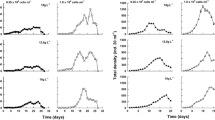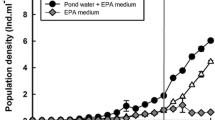Abstract
The combined effects of food (Chlorella) and temperature on the population growth of a laboratory clone of the rotiferBrachionus patulus were studied. The intrinsic rate of increase (r) as well as the maximum densities achieved were a function of temperature. While ther was negative at 15°C regardless of food level, its magnitude was dependent on food level at medium (25°C) and high (35°C) temperatures, indicating a significant temperature × food interaction. The seasonal variations in the abundance ofBrachionus patulus in the plankton of a regularly sampled pond are explained in terms of the observed food-temperature effects on the survival and reproduction of the laboratory population.
Similar content being viewed by others
References
Arora H C 1966 Responses of rotifera to variations in some ecological factors;Proc. Indian Acad. Sci. B63 57–66
Duncan A 1983 The influence of temperature upon the duration of embryonic development of tropicalBrachionus species (Rotifera); inLimnology of Parakrama Samudra, Sri Lanka (ed.) F Schiemer (The Hague: Dr W Junk Publ.) pp 107–115
Duncan A 1984 Assessment of factors influencing the composition, body size and turnover rate of Zooplankton in Parakrama Samudra, an irrigation reservoir in Sri Lanka;Hydrobiologia 113 201–215
Dussart B H, Fernando C H, Matsumura-Tundisi T and Shiel R J 1984 A review of systematics, distribution and ecology of tropical freshwater Zooplankton;Hydrobiologia 113 77–91
Edmondson W T 1965 Reproductive rates of planktonic rotifers as related to food and temperature in nature;Ecol. Monogr. 35 61–111
Galkovskaja G A 1987 Planktonic rotifers and temperature;Hydrobiologia 147 307–317
Gatesoupe F J and Luquet P 1981 Practical diet for mass culture of the rotiferBrachionus plicatilis: application to larval rearing of sea bassDicentrarchus labrax;Aquaculture 22 149–163
Gilbert J J 1988 Suppression of rotifer populations byDaphnia: a review of evidence, the mechanisms and the effects on zooplankton community structure;Limnol. Oceanogr. 33 1286–1303
Halbach U 1970 Einfluss der Temperature auf die populations dynamik des planktischem RädertieresBrachionus calyciflorus Pallas;Oecologia (Berlin)4 176–207
Halbach U 1979 Introductory remarks: strategies in population research exemplified by rotifer population dynamics;Forschr. Zool. 25 1–27
Halbach U 1984 Population dynamics of rotifers and its consequences for ecotoxicology;Hydrobiologia 109 79–96
Halbach U and Halbach-Keup G 1974 Quantitative beziehungen-zwischen phytoplankton und der populationsdynamik des RotatorsBrachionus calyciflorus Pallas. Befunde aus laboratoriumsexperimenten und frielanduntersuchungen;Arch. Hydrobiol. 73 273–309
Halbach U, Siebert M, Wissel C, Klaus J, Beuter K and Delion M 1981 Population dynamics of rotifers as bioassay tool for toxic effects of organic pollutants;Verh. Int. Verein. Theor. Angew. Limnol. 21 1141–1146
Herzig A 1983 Comparative studies on the relationship between temperature and duration of embryonic development of rotifers;Hydrobiologia 104 237–246
Herzig A 1987 The analysis of planktonic rotifer populations: a plea for long-term investigations;Hydrobiologia 147 163–180
Hirata H 1979 Rotifer culture in Japan; inEurop. Maricult. Soc. Spec. Publ. No. 4 (eds) E Styczynska-Jurewicz, T Backiel, E Jaspers and G Persoone (Bredene: Belgium) pp 361–375
Hofmann W 1977 The influence of abiotic factors on the population dynamics in planktonic rotifers;Arch. Hydrobiol. Beik. Ergebn. Limnol. 8 77–83
James C M and Abu-Rezeq T S 1989 An intensive chemostat culture system for the production of rotifers for aquaculture;Aquaculture 81 291–301
James C M, Bou-Abbas M, Al-Kharas A M, Al-Hinty S and Salman A E 1983 Production of the rotiferBrachionus plicatilis for aquaculture in Kuwait;Hydrobiologia 104 77–84
Jyotl M K and Sehgal H 1979 Ecology of rotifers of Surinsar, a subtropical, freshwater lake in Jammu, Jammu and Kashmir, India;Hydrobiologia 65 23–32
Krebs C J 1985Ecology. The experimental analysis of distribution and abundance 3rd edition (New York.: Harper and Row)
Lubzens E 1987 Raising rotifers for use in aquaculture;Hydrobiologia 147 245–255
Nogrady T 1982 Correlation of rotifer associations in a chain of lakes fed by reclaimed sewage;Hydrobiologia 89 277–284
Poole R W 1974An introduction of quantitative ecology (New York: McGraw-Hill)
Pourriot R and Rougier 1975 The dynamics of a laboratory population ofBrachionus dimidiatus (Bryce) (Rotatoria) in relation to food and temperature;Ann. Limnol. 11 125–143
Radwan S 1980 The effect of some biotic and abiotic factors on the fertility of planktonic rotifer species;Hydrobiologia 73 59–62
Rothhaupt K O 1985 A model approach to the population dynamics of the rotiferBrachionus rubens in two-stage chemostat culture;Oecologia 65 252–259
Sarma S S S 1987Experimental studies on the ecology of Brachionus patulus (Muller) (Rotifera)in relation to food, temperature and predation, Ph.D. thesis, University of Delhi, Delhi
Sarma S S S and Rao T R 1987 Effect of food level on body size and egg size in a growing population of the rotiferBrachionus patulus Muller,Arch. Hydrobiol. 111 245–253
Sarma S S S and Rao T R 1990 The combined effects of food and temperature on the life history parameters ofBrachionus patulus Muller (Rotifera);Int. Revue Ges. Hydrobiol. (in press)
Vasisht H S and Sharma B K 1976 Seasonal abundance of rotifer populations in a freshwater pond in Ambala city (Haryana) India;J. Zool. Soc. India 28 35–44
Walz N 1987 Comparative population dynamics of the rotifersBrachionus angularis andKeratella cochlearis;Hydrobiologia 147 209–213
Williamson C E 1983 Invertebrate predation on plankton rotifers;Hydrobiologia 104 385–396
Author information
Authors and Affiliations
Rights and permissions
About this article
Cite this article
Sarmat, S.S.S., Rao, T.R. Population dynamics ofBrachionus patulus Muller (Rotifera) in relation to food and temperature. Proc Ani Sci 99, 335–343 (1990). https://doi.org/10.1007/BF03186403
Received:
Issue Date:
DOI: https://doi.org/10.1007/BF03186403




